1910sClick Here to hear "Livery Stable Blues" recorded in 1917 by the New Orleans Dixieland Jass Band. This is the first jazz recorded ever recorded. 1917 Painting of Lugger LandingThe Painting: Lugger Landing, Esplanade Avenue (Old Basin Canal) 1917 The Artist: Robert Grafton (1876-1936) Source: Louisiana State Museum 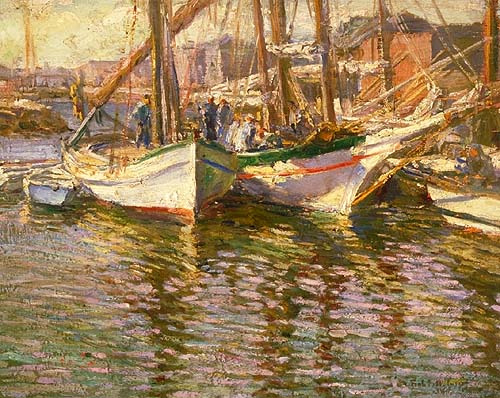 1910 Spanish Fort postcard1910 - Postcard Postcard postmarked 1910. F. M. Kirby & Company of New Orleans Louisiana issued this view of the "Old Spanish Fort" in New Orleans. 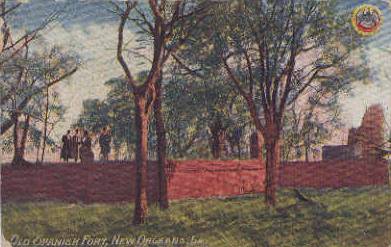 1910 West End postcard"Scordill" postcard of West End summer & Winter Resort, New Orleans, LA. Attractions include amusement rides, Thoms Gate, & the Macki Saloon.  1915 New Canal Light damaged by hurricaneSeptember 29th, 1915: A violent hurricane reached New Orleans. The then 10 foot high levee protecting the city began to be questioned as not being high enough after the passage of this storm (Orleans Levee District). The pressure fell to 28.01" on a ship in the New Orleans harbor...New Orleans saw as high as 98 m.p.h.. Franklin had 14.43" of rain during the storm, while New Orleans saw over 8"...The New Canal lighthouse was heavily damaged as winds of 130 mph raged, and the pressure fell to 28.11"....which at the time set a record for the lowest pressure measured on land in the United States...Thirteen million dollars of damage, $5 million in New Orleans alone, were caused and 275 people died. Many of those who perished refused to leave low lying areas in advance of the storm, despite ample warning. 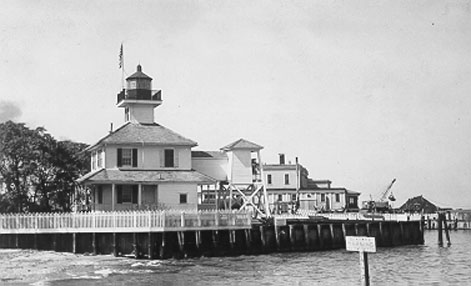 1912 Social Life in Old New Orleans by Eliza Ripley'There was a large hotel (there may be still - it is sixty years since I saw it), mostly consisting of spacious verandas, up and down and all around, at the lake end of the shellroad, where parties could have a fish dinner and enjoy the salt breezes, but a dinner at 'Lake End' was an occasion, not a climax to a shopping trip. The old shellroad was a long drive, Bayou St. John on one side, swamps on the other, green with rushes and palmetto, clothed with gay flowers of the swamp flag. The road terminated at Lake Pontchartrain, and there the restful piazza and well-served dinner refreshed the inner woman.' 'There was no coin in circulation of less value than a picayune...we children felt rich when we had one tied in the corner of our handkerchief.' 'We all must have known some 'picayune people.' There was a family living near us who owned and occupied a large, fine home on St. Joseph Street, while we and the Grimshaws and Beins lived in rented houses near by. They had, besides, a summer home 'over the lake' (and none of us had!). Often, on Mondays, a fish, or a quart of shrimp, or something else in the 'over the lake' line, was sent to one of us, for sale. We used to laugh over the littleness of the thing. A quart of shrimp for a picayune was cheap and tempting, but none of us cared to buy of our rich neighbor...' Source: Documenting the American South 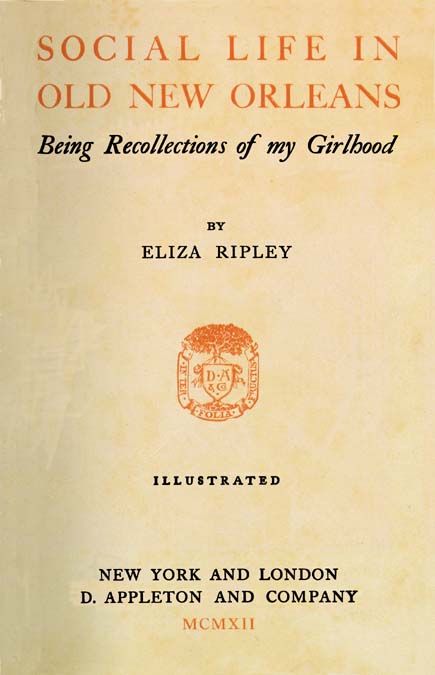 1913 Army Corps Of Engineers chart and report (see below)of a survey of Bayou St. John at the entrance to the lake.John at the entrance to the lake. The map is dated 1913 and includes Spanish Fort Park, Soundings, A Rollercoaster, Houses, The Spanish Fort Lighthouse, The N.O. Ry. & L. Co. (Electric Railway), a Boat House, a Sunken Dredge, and more. This map was removed from the U.S. Army Chief Of Engineers Report Of 1915 (see sample pages below). The report is 20 pages long and contain statistics of the survey, costs of proposed improvements, some commercial statistics, etc. The map is 17" by 13". 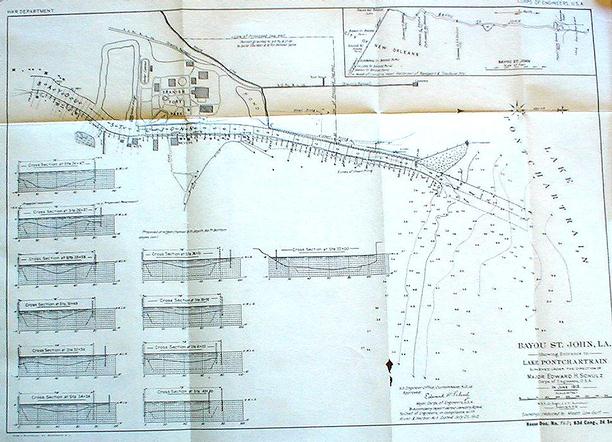 1913 Army Corps Of Engineers chart description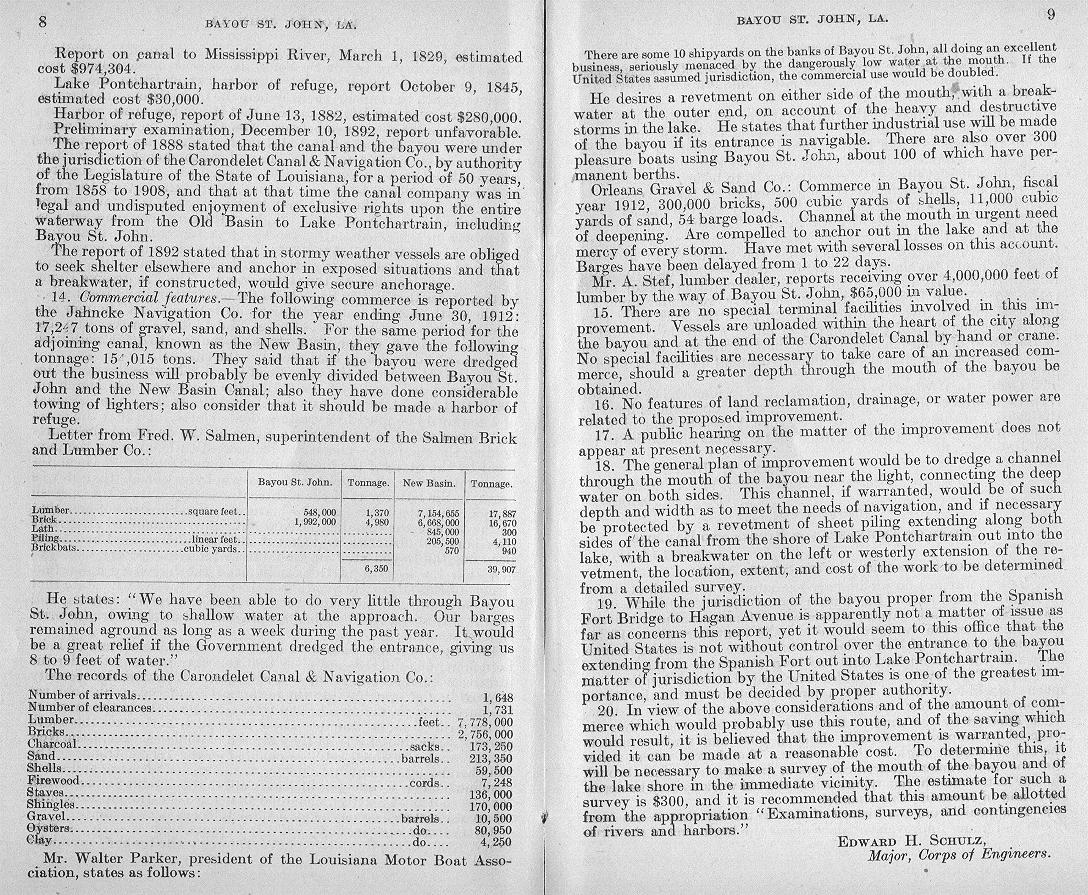 Alcide (Yellow) Nunez' Moonlight Serenaders1884-1934 - Alcide (Yellow) Nunez The Moonlight Serenaders...played regularly along the lakefront north of New Orleans at places like Milenburg and Little Woods. They accompanied the Boswell Sisters early in their carrer. Source: http://www.geocities.com/BourbonStreet/5135/WCBE.html 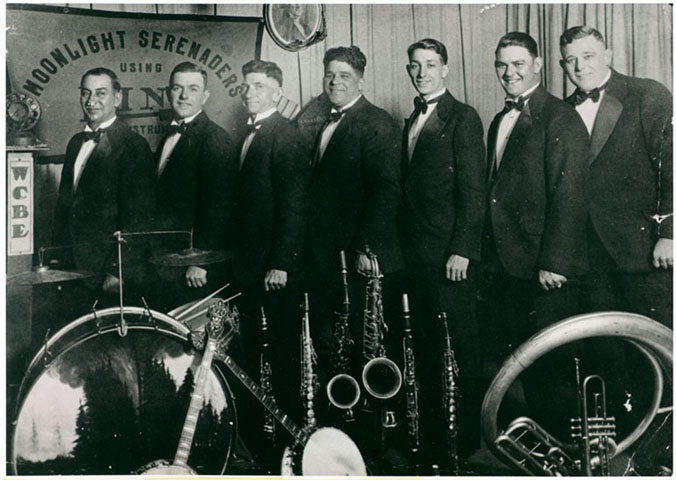 1918-1928 Armond Piron (with Peter Bocage) as A.J.Piron & his Novelty Orch., played at several venues on the Lake1888-1943 - Armond ( A.J.) Piron Armond ( A.J.) Piron () "...the "society" band. These groups, such as the bands led by A. J. Piron and John Robichaux, worked at prestigious locations like Tranchina's restaurant and gambling rooms on Lake Pontchartrain..." Source: James Lincoln Collier The New Grove Dictionary of Jazz, Macmillan Reference Ltd 1988 From 1918-1928 Piron along with Peter Bocage formed the A.J.Piron & his Novelty Orch., and played at Tranchina's Restaurant in Spanish Fort, on Lake Pontchartrain, LA. Source: DIXIELAND JAZZ http://nfo.net/.WWW/JOB.html Piron...played for many years at the New Orleans Country Club on Lake Pontchartrain... http://www.redhotjazz.com/piron.html  Tom Brown played Jass on the Lake & steamers crossing to the North Shore1888-1958 - Tom Brown Brown claimed to be the first to use the word "Jass" to descibe the music that was coming out of New Orleans. For a while, both black and white bands had found plenty of seasonal employment at the beachfront restaurants, pavilions, and cabarets lining the south shore of 635-square-mile Lake Pontchartrain, less than five miles north of the city. Tom Brown's band was even one of the few that got to play on the excursion steamers that took tourists to the more exclusive north shore. But Pontchartrain's heyday ran in cycles, subject to sometimes violent weather and changing fashion. It ended forever when, in the mid-1920s, construction began on a seawall to extend the existing shoreline out several hundred feet, protecting it from storms and flooding--and leaving the former resort area stranded inland. Source: http://www.nytimes.com/books/first/s/sudhalter-chords.html Like most early White New Orleans Jazz musicians, trombonist Tom Brown was a veteran of Papa Jack Laine's Reliance. Brown's Dixieland Jass Band consisted of Tom Brown on trombone; his brother Steve on bass, Ray Lopez on cornet; William Lambert on drums; Arnold Loyacano on guitar; and Larry Sheilds on clarinet. Once in New York, Brown's clarinetist, Larry Sheilds exchanged jobs with Yellow Nuñez who had just been fired from The Original Dixieland Jass Band. Nuñez joined Browns band. In New Orleans he played with Johnny Bayersdorffer and his Jazzola Novelty Orchestra. Source: http://www.redhotjazz.com/brown.html  1917 The First Jazz Recording1889-1961 - Dominic (Nick) LaRocca The Italian Connection? ...all citizens had access to the music which was performed on the streets, at the camps at West End, and in the cabarets and dance halls...The Original Dixieland Jass Band (ODJB) was, in 1917, the first jazz group to be recorded. It included Nick LaRocca and Tony Sbarbaro. Other notable Italian jazz originators are Leon Roppolo, Tony Parenti, Charlie Scaglioni, Santo Pecora, Sherwood Mangiapane, Joseph Manone, Curly Lizana, Charlie Cordilla, Joseph "Wingy" Manone, Sharkey Bonano, Tony Parenti, and Louis Prima. Source: http://members.aol.com/ODJBjazz/odjbhistory.html 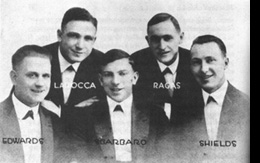 Ray Lopez played with Tom Brown's BandSee info on Tom Brown 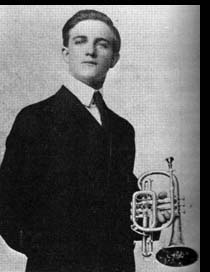 1913 Leon Ropollo begins playing Jazz on the Lake1902-1943 - Leon Roppolo Leon Roppolo was considered a genius by his contemporaries and like Bix Beiderbecke and Buddy Bolden, he was another of the tragic young men of early Jazz. He is remembered as being a pioneer of the jazz solo, as opposed to the collective improvisation of most New Orleans bands and for his lyrical and modern clarinet and alto saxophone playing. He was born in Lutcher Louisiana, upriver from New Orleans. His family moved to New Orleans about 1912 with in a year or two he was playing music professionally at Lake Pontchartrain and Bucktown." Source: http://www.redhotjazz.com/roppolo.html  1914 - John Quarrella's Midway Restaurant at MilneburgThis photo was probably taken in late summer 1914. In the photo (left to right) are Gennaro "John" Quarrella, his wife Marie Bonano, Gennaro's brother Joseph Quarrella, and Mr. Conti, the bartender at the Midway. Notice the "Ladies Entrance" sign--something not seen in many years. Images and text about Quarrella's Midway Restaurant & Saloon courtesy of the Descendants of Gennaro "John" Quarrella and Marie Bonano. 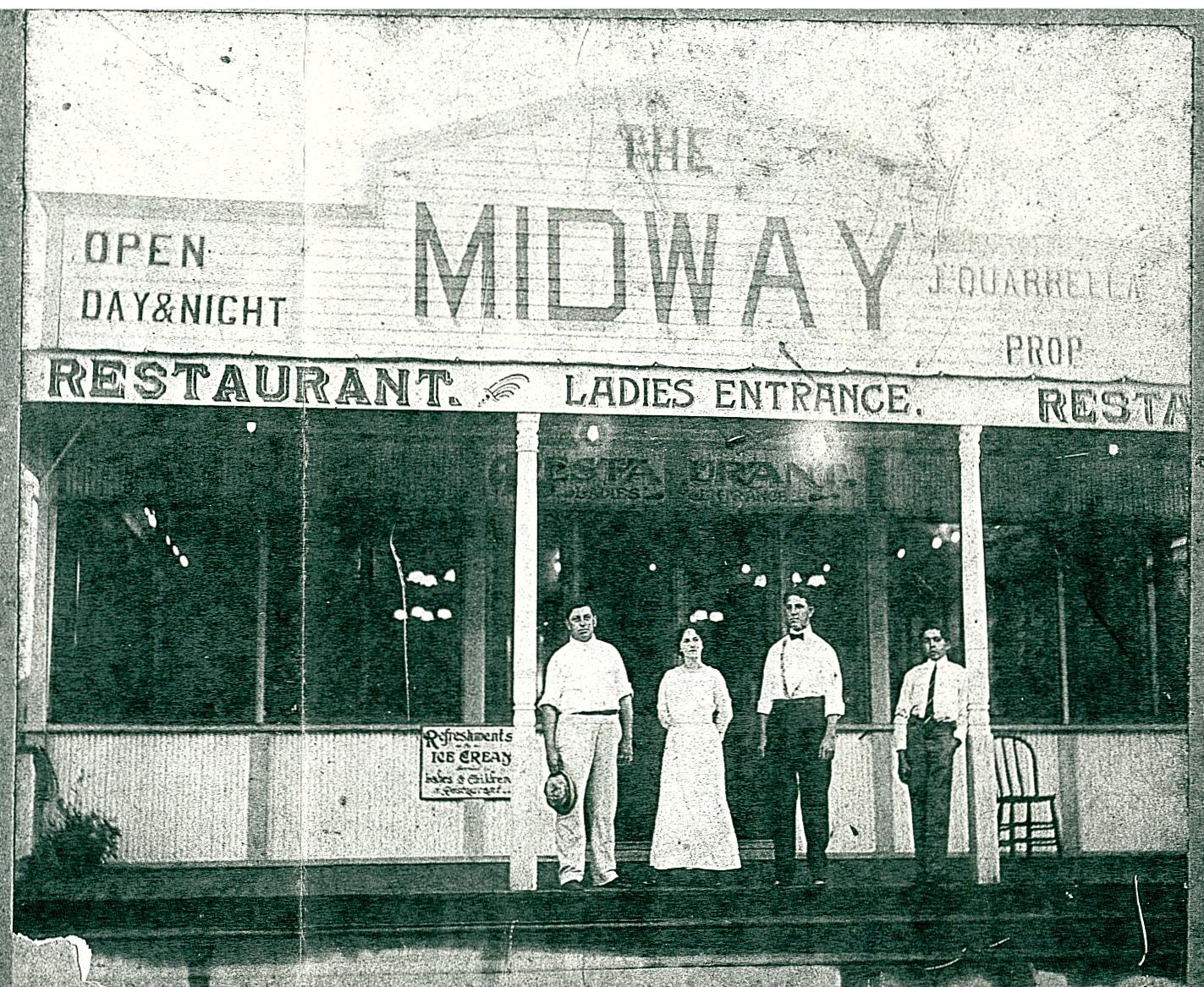 Tranchina's West End Hotel RestaurantPostcard, date unknown. "Tranchina's West End Hotel Restaurant, LA." Many early Jazz greats have been documented to have played at Tranchina's. 1918 - Society Bands such as the bands led by A. J. Piron and John Robichaux, worked at prestigious locations like Tranchina's From 1918-1928 Piron along with Peter Bocage formed the A.J.Piron & his Novelty Orch., and played at Tranchina's Restaurant in Spanish Fort, on Lake Pontchartrain, LA. Source: DIXIELAND JAZZ http://nfo.net/.WWW/JOB.html Photo shows Tranchina's West End Hotel Restaurant, LA 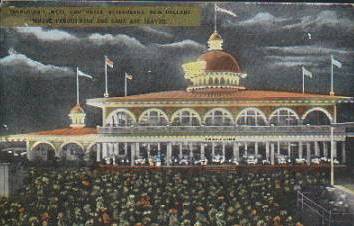 1919 Southern Yacht Club postcardPostmarked 1919 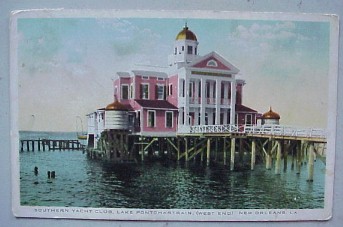 1910s Alcide Nunez plays at a campAlcide Nunez, right, with his nephew, violinist Harry Nunez, in the early 1910s. In this photo they were playing at one of the old camps on Lake Pontchartrain with Frank Christian's Band. Nunez worked in the bands of his friends cornetist Frank Christian and trombonist Tom Brown. At least on occasion, Nunez put together a band under his own name. But for years his most important work was with bandleader Papa Jack Laine. Source: http://www.geocities.com/BourbonStreet/5135/NuStart.html 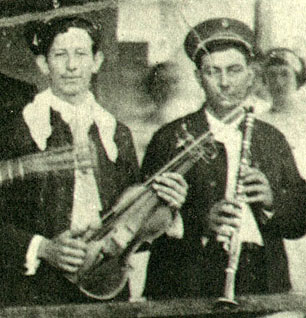 1910s Southern Yacht Club postcardRaphael Tuck & Sons Postcard view of the West End of the Southern Yacht Club. Believed to be pre-1915. 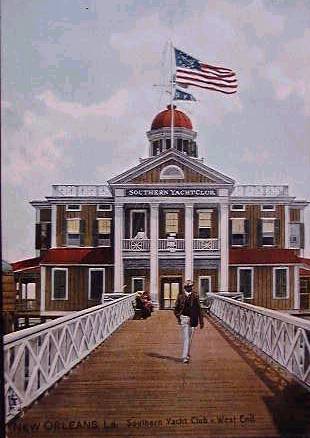 1910 - The New Canal Light is movedThe New Canal Light, was one of a series of octagonal wooden lighthouses built in 1838, that surrounded Lake Pontchartrain. It was built on pilings then relocated to its present site in 1910. 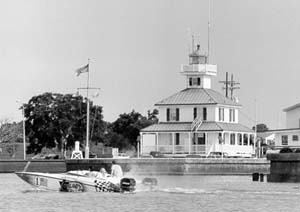 1911 Postcard - Sailing on Lake PontchartrainTucks oilette postcard titled "Yachts at west end of Lake Pontchartrain, La." 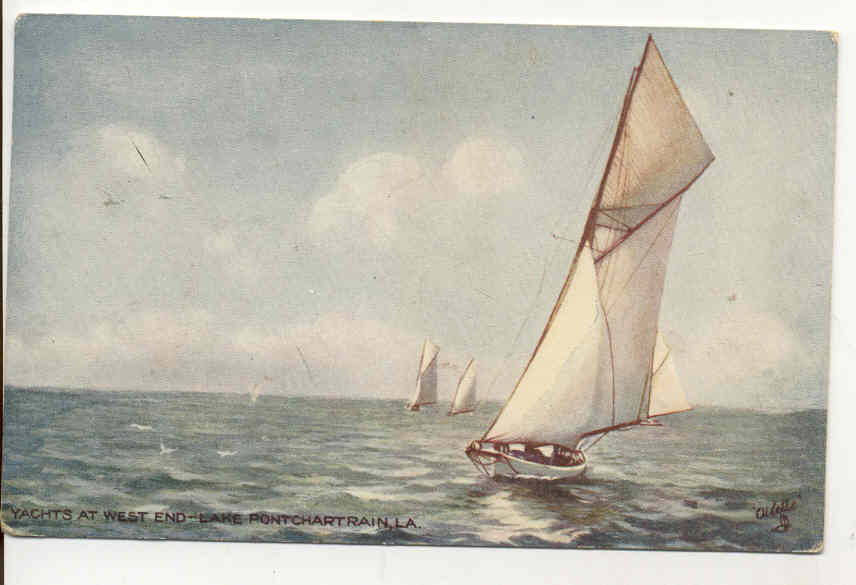 1915 New Canal Light postcardCirca 1915 postcard reads "Ligthouse at West End, New Orleans, La." 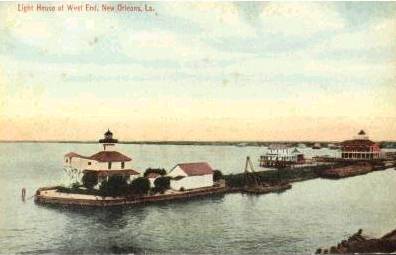 1915 Panoramic ViewPanoramic view of the west end of Lake Shore Park in 1915. Please scroll to the right to see the many camps existing at that time.  1910 - Railroad Station at Spanish FortThis postcard, from about 1910, was published by C.B. Mason, of New Orleans, Louisiana. The card pictures the Railroad Station at Spanish Fort in New Orleans. The description on the back reads, "Historical Spanish Fort on the shores of Lake Pontchartrain operated by the New Orleans Railway & Light Co., New Orleans, La." 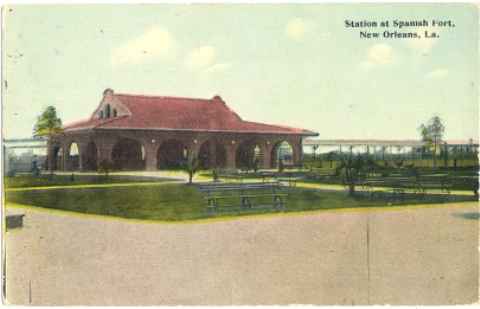 1912 Spanish Fort postcardA popular resort on the shore of Bayou St. John at the Lake during the 19th and early 20th century. This post card uses a 1912 photograph to advertise some of the delights that awaited anyone who rode the streetcar out to the end of the bayou. All that remains of the resort are the ruins of the colonial fortification that gave its name to the area. The amusement park moved to the end of Elysian Fields Avenue in the 1930s; we remember it well as Pontchartrain Beach. Source: New Orleans Public Library--Crescent City Memory Collection http://www.gnofn.org/~nopl/exhibits/ccmem/4.htm 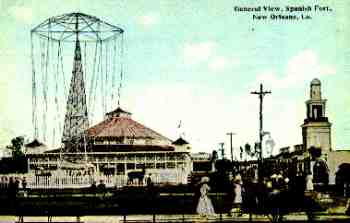 1912 Bath House at Spanish Fort1912 Postcard. Reads "Entrance to Bath House Spanish Fort on Lake Ponchartrain, New Orleans, Louisiana" Copyright 1912 H.J.Harvey 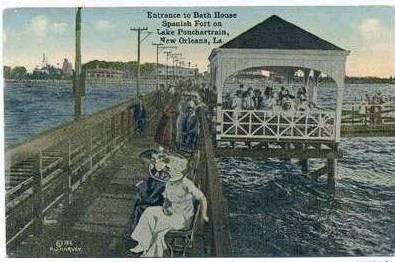 1915 postcard of Spanish Fort & Bayou St. John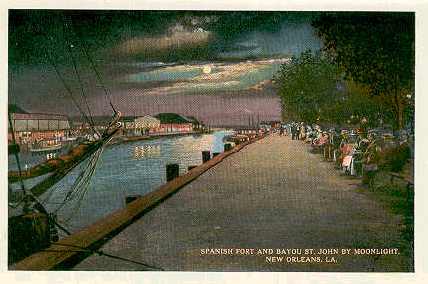 1910s Men with canon at Spanish FortSpanish Fort Ruins Title: Spanish Fort Description: Suited men standing behind a cannon at Spanish Fort. Source: Louisiana State Museum http://appl005.lsu.edu/LSM.nsf/0d6463f4d93cecd68625689c00470f5c/664159a2e80fffbe862569f9004f91b8?OpenDocument 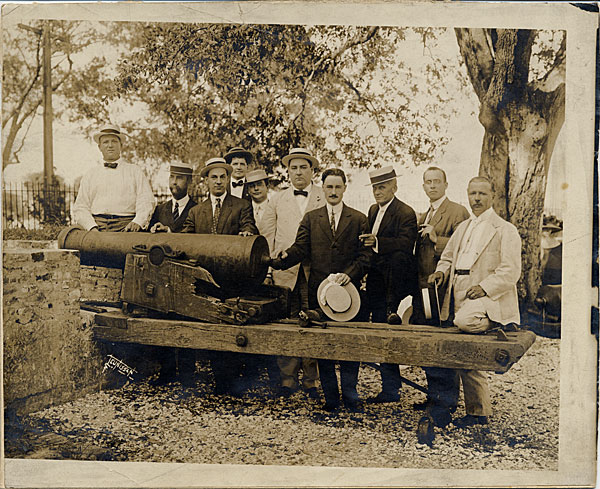 1910 postcard - Spanish Fort grave of Sancho PabloGrave of Sancho Pablo, New Orleans, La 1910. Unmailed card, circa 1910’s, some wear, Grave of Scanchos Pablo, he was the first commander of Spanish Fort, he was was in love with an Indian girl whose father disliked him and killed him when he discovered them meeting under the trees where he is buried. 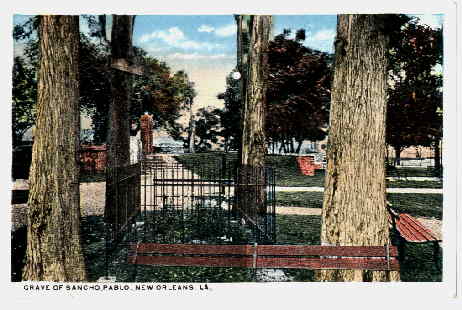 1913 Milneburg Light Postcard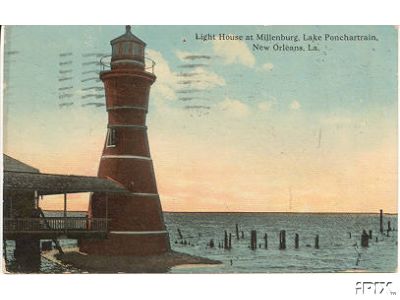 1914 PostcardReads "CAPTURING OF AN INHABITANT OF THE MARSHES NEAR LAKE PONTCHARTRAIN" 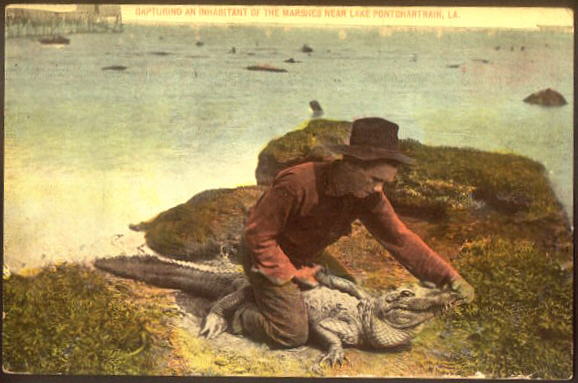 1919 The Picayune SailsLeonard Nicholson's gaff-rigged sloop, "Picayune," beats to windward on a choppy Lake Pontchartrain in the summer of 1919. An active member of the Southern Yacht Club, Mr. Nicholson was the publisher and president of the Times-Picayune from 1922 until his death in 1951. (Photograph provided by J. Gilbert Scheib, SYC) Collection of Frank Gordon & Son New Orleans, Louisiana USA Source: http://www.bergeronstudio.com/fg01/p57.html 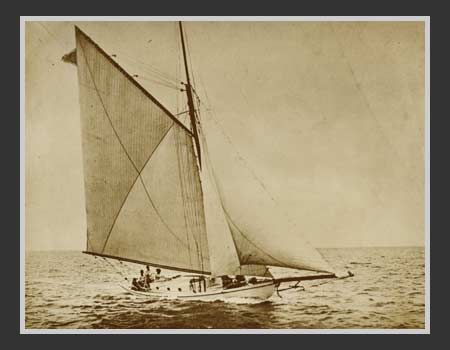 1914 West EndThree well-dressed New Orleansians take their leisure at Lake Pontchartrain on a sultry Sunday afternoon just prior to the outbreak of World War I. In the background is the Southern Yacht Club, second oldest in the United States, having been founded in 1849. The buxom lass in the foreground probably made a pretty good crew member in a small sailboat in a stiff breeze - provided, of course, she didn't sit on the wrong side. The joli chapeau could be used to bail water. Photograph provided by J. Gilbert Scheib, SYC. Collection of Frank Gordon & Son New Orleans, Louisiana USA Source: http://www.bergeronstudio.com/fg01/p58.html 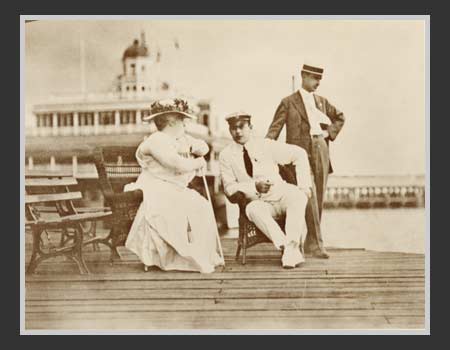 1913 - N. O. & N. E. Railroad PostcardShows train crossing the lake. 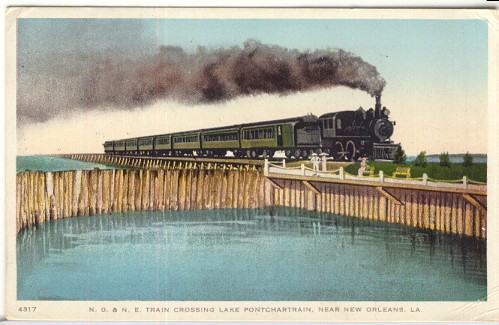 1914 Postcard - Spanish Fort Goldfish PondPostcard, Gold Fish Lake, at the Spanish Fort, New Orleans, La. Postmarked 1914. Published by J.Scordill. 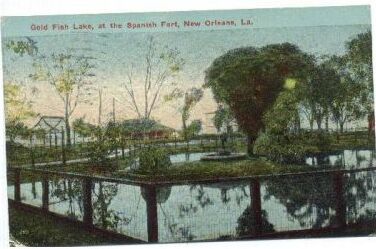 1919 Inner Harbor CanalAd supposedly sponsored by the mayor of New Orleans while trying to secure the 1920 Rotary Convention. 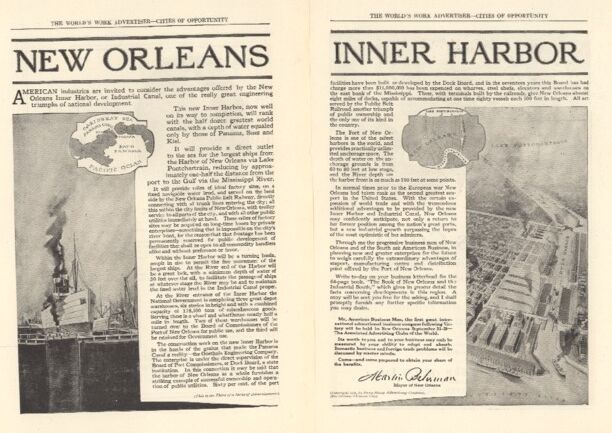 1910s ? Alligator RideA pre-1920 photo view of two boys riding on an alligator named Ponchatrain Bill (look closely at the sign). Probably one of the atttractions at Spanish Fort Amusement Park. 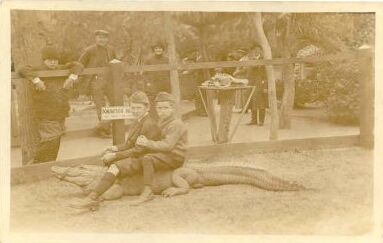 1915 Casino at Spanish FortPostcard postmarked 1915. Published by The Acemegraph Co., Chicago. 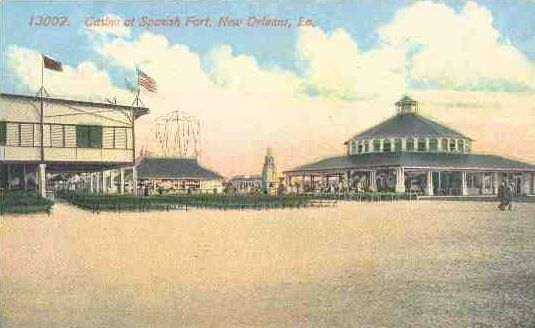 1913 Spanish Fort Mapby the U.S. Army Corp of Engineers War Department 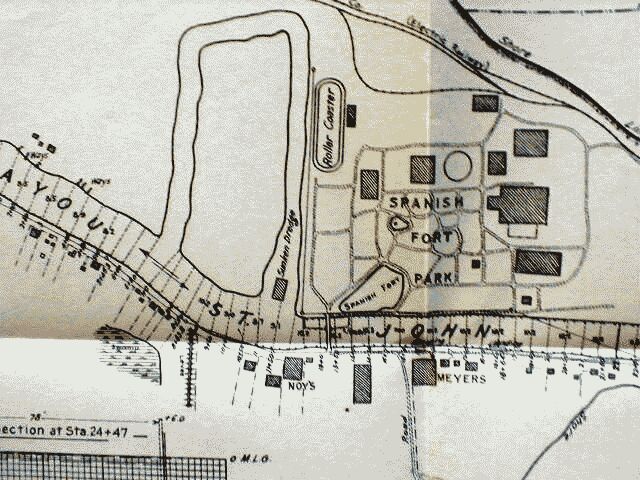 |
|
